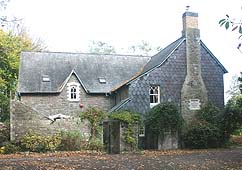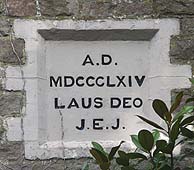|
The
Gwent Local History Council was set up in 1954 to encourage public interest
in local history, to bring together societies and persons interested
in the study of local history, to arrange lectures and publish the results
of historical research. Their twice yearly magazine "Gwent Local
History" has made a valuable contribution to the store of historical
knowledge. Here Caerleon Net, with the full agreement of the Gwent Local
History Council, is making available many of the articles from this
magazine relating to Caerleon.
Please note: copyright exists on all texts. Enquiries relating copyright should be addressed to the Gwent Local History Council. |
||||||||||||
|
Gwent Local History No. 39, Spring 1975 Rev. Daniel Jones, M. A. Vicar of the Parish Church of Llangattock-juxta-Caerleon An extract from the Caerleon and District Local History Society.
During his stay in Caerleon Rev. Daniel Jones was active in practically all social activities which went on. He initiated a course of lectures in 1855 which became extremely popular, and carried on for some years, the first lecture on the "Antiquities of Caerleon" being given by the Reverend gentleman himself. When on 17th March 1849 the Museum of Antiquities was opened in Caerleon, he is listed as one of the Committee in charge. The Town Hall which was falling down had been purchased by Sir Digby Mackworth. This was removed and rebuilt as a new Museum. Subscriptions of l0 shillings were invited, and Daniel Jones gave a donation of £2. He was also Chairman of the School Governors, which duty he pursued extremely well. On 2nd July 1852, at the Annual General Meeting of Caerleon Antiquarian Association at the Free Schoolroom, Caerleon, the Rev. Daniel Jones gave a paper on the "Notice of the discoveries in excavating for the foundation of the new Church at Risca". This was delivered in a masterly and graphic style. In August 1852 the brethren of the Loyal King Arthur Lodge of Oddfellows celebrated their anniversary. They formed a procession to the Church, where a most interesting sermon was delivered by the Vicar, the Rev. D. Jones, from the 126th Psalm, verses 2, 3 and 4. Rev. Jones also took the chair at the excellent dinner which followed. He attended these meetings, together with the meetings of The Mechanics Institute throughout his stay in Caerleon. On the 8th November 1856 the local newspaper reports: "We have heard with pleasure that preliminary steps have been taken, at the suggestion of a gentleman of position, who recently visited Caerleon for the purpose of presenting the Rev. D. Jones, Vicar of the Parish, with some tangible expression of the regard of his parishioners and others. For about a quarter of a century we believe the Reverend gentleman has discharged with affection and fidelity the duties of a Christian Minister and Pastor, and has, during that protracted period, deservedly enjoyed the esteem of the people in his charge". On 21st February 1857 the Schoolroom at Caerleon Charity Schools was crowded to the doors, when a Testimonial was made to the Rev. Daniel Jones. The account reads: "This gentleman, having justly earned the affection of his Parishioners by the zealous and faithful discharge of his pastoral functions, a subscription was recently organised to procure a fitting testimonial for his acceptance, in appreciation of his labours in the Parish". A handsome sum was accordingly subscribed and, at a meeting of the subscribers in the Free School, on Saturday evening, the token of esteem was presented to the Reverend gentleman. T. M. Llewellyn, Esq., presided, and presented the testimonial, which consisted of an elegant silver salver and pocket communion service, with a purse of 20 guineas. In his speech he accorded in neat terms to the great public usefulness and goodness of mind and heart of the Rev. Jones, who, he hoped, would be long spared in life to his attached parishioners". The salver bore the following inscription: 'Presented to the Rev. Daniel Jones, M.A., by his parishioners and friends as a mark of esteem and regard for the faithful discharge of his Christian duties as Vicar of Caerleon for upwards of twenty-five years. 30th January 1857'. The Reverend gentleman, in warm terms, gratefully acknowledged the gift. A few months later, on 3rd October 1857, the following announcement appeared in the Monmouthshire Merlin, under the heading of Deaths: "3rd October 1857. On the 29th ult. at the Vicarage, Caerleon, the Rev. Daniel Jones, M.A., aged 61 years. Deceased had been for a great number of years Vicar of the Parish and, by his Christian deportment and uniform kindness to the poor, was deservedly esteemed and his death is deeply regretted". There is no account of his funeral but, from the School's Log Book we read that "he was buried at Caerleon, St. Cadoc's Church, on 2nd October. The Schools were closed for the day. The death bell tolled 61 times, once for every year of his life, each day between the day of his death and the day of his funeral. The entire school attended the funeral, and at the request of the family, recited the 39th Psalm". We wonder what would happen today if such a request was made, even for the Chairman of the School Governors. His only son, John Edward Jones, also took Holy Orders, and after ordination became Curate of Alfreton in Derbyshire. He was there at the time of his father's death and then came south from Derbyshire to take over his father's parish of Caerleon for several months, until a new incumbent was appointed. In 1858 he himself became Vicar of Llanthewi Vach and Llandegfedd. He married Janet Robina Machen and, in order to enable them to benefit under the terms of a Family Will, he added the name Machen to that of Jones. He it was who designed the Rectory at Llanthewi, in the walls of which is embedded a stone engraved M.D.C.C.C.L.X.I.V. Sans Deo J.E.J. Whilst this was being built, he, with his wife and mother, resided at No. 33 High Street, Caerleon, in the house which belonged to his mother and where she lived with his father's two maiden sisters, Anne and Maria. It was here that Daniel Jones's grandson, Arthur Llewellyn Jones-Machen was horn on 3rd March 1863. When the new Rectory was finished, Arthur at one year old was taken to live at Llanthewi and here he was brought up by his aunts, for his mother became a permanent invalid. It was his aunt Maria who told Arthur that his grandfather was "a most amiable man, but he could not bear radishes, or the Adeste Fideles". |
||||||||||||
 |
 |
|||||||||||
|
The
Rectory at Llanthewi - photos ©
CAERLEON NET
|
||||||||||||
 |
||||||||||||
|
CAERLEON
NET |
||||||||||||
